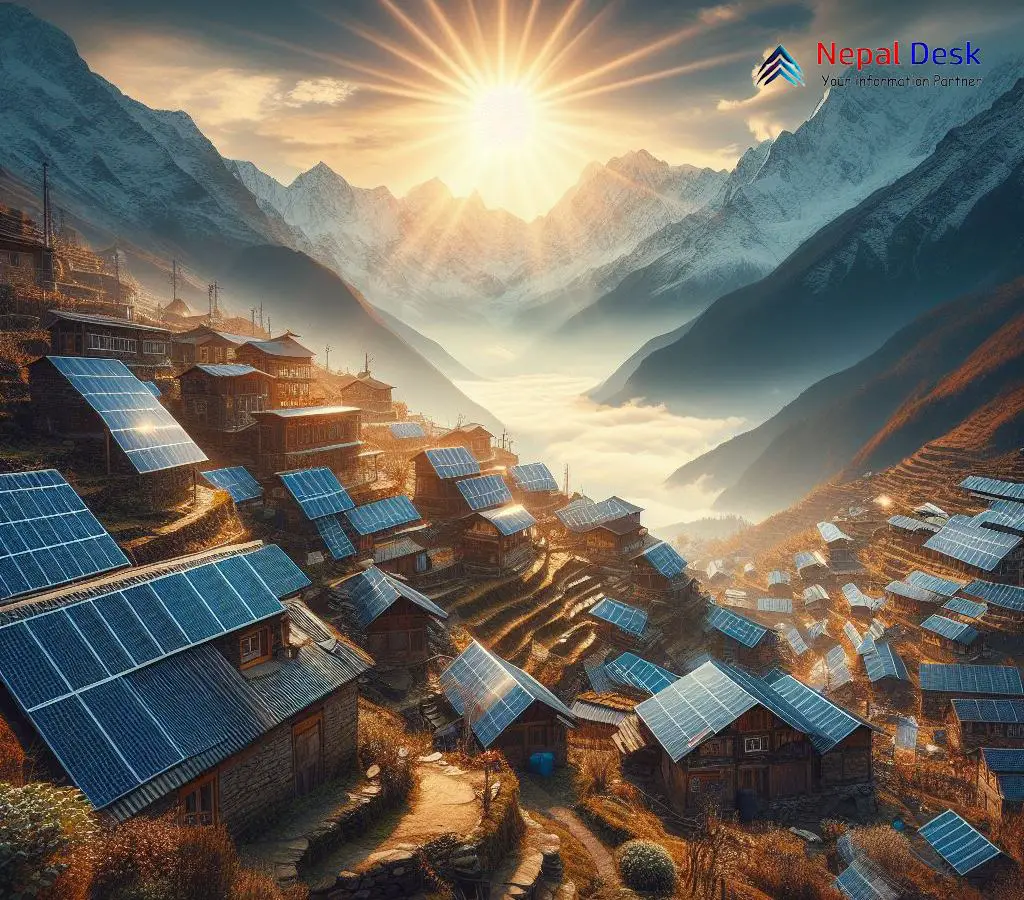Nan, Village Enroute to Chho-Rolpa Lake, Lightened with Solar Energy
Published Date

Published Date
Stopover Village to Chho-Rolpa Lake, Nan at an elevation of 4,180m , enlightened with solar energy; Explore the potential of Solar Energy in Nepal.
⏱ 5 min read
Nestled at the summit of its district, the village of Na, a popular destination for travelers drawn to its abundance of Tuki, is now aglow with electric light due to the installation of a new 30 KW solar power plant. The project has transformed Jhilimili into a beacon of tourism within the Gaurishankar Rural Municipality-9.
Perched at an impressive elevation of 4,180 meters is Nan Chho-Rolpa, an essential stopover for visitors on their journey to the Chho-Rolpa Lake. To bring light to 73 homes in this high-altitude village, the Alternative Energy Promotion Center invested the lion's share, 31.4 million rupees (90%), with additional funding coming from the Water Resources and Irrigation Development Division Charikot (2.5 million rupees) and Gaurishankar Rural Municipality (998 thousand rupees), totaling an investment of 30.48 million rupees.
Previously, residents of Nan village graciously catered to tourists without electrical aid. The locale predominantly hosts hotels among its residential buildings. It was conveyed by the Center that each home now enjoys electrical service, facilitated by individual 30-kilowatt solar installations—a more cost-effective solution than extending the national grid due to high transport costs.
The arrival of electricity was met with jubilation by locals in this enclave named Him Arohi. Dabachhiring Sherpa expressed his community’s delight as they transcended an era dependent on Tuki lamps into one illuminated by modern energy solutions.
"We marked the electrification with celebratory dances," shared Dabachhiring Sherpa, noting that despite Naam being a hub for tourists, it lacked elementary facilities such as healthcare and reliable mobile connectivity. He lamented that bolstered government efforts could have ushered these basic services alongside lighting solutions. Accessing Naam is a challenge; a three-day trek from the nearest road is necessary. As a makeshift solution for culinary needs, gas is used to prepare meals for visiting tourists.
Chho-Rolpa has been attracting both international and local nature enthusiasts to explore Himtal. This segment of Rolwaling Valley lies under snow for four months annually, yet an anomaly in snowfall patterns prompted unaffected domestic tourism during what would typically be downtime. "The local protocol is to shut the hotels around Nanka as November’s chill sets in," he remarked, detailing how solar panels were airlifted into Naam due to hazards associated with carrying them manually.
This aerial delivery system ensured both equipment and technicians arrived safely to orchestrate successful lighting operations within homes. Although power lines have reached nearby Beding in Rolwaling Valley and mobile service towers by Nepal Telecom are operational, Naam still faces communication challenges.
The Ngawang Tenji Lama, the monastery leader, said how this isolation is detrimental to residents and tourists as it can hinder rescue operations almost impossible during emergency situations due to the absence of mobile connectivity. Though state regulations have been enhanced due to an increase in tourist activities, it should be noted that emergency communication tools were not included in those provisions for prompt interventions in distress situations. Lama however is upbeat that the situation will get better after the recent electrification process.
The area adjoining Naam in Vigu Rural Municipality-1 from Aw District where electricity has already advent, and Lapchi and Lamnang are the only remaining points without electricity access in this difficult terrain.
Solar Power's Potential in Nepal: A Snapshot
Nepal boasts abundant potential to diversify and capitalize on solar energy. Bathed in plentiful and cost-effective solar energy, the nation's yearly solar capacity sits at a staggering 50,000 terawatt-hours. To put this into perspective, that's over 7,000 times the current electrical consumption and a hundredfold of its existing hydroelectric capabilities.
On the ground, a variety of privately-led solar initiatives such as the Mithila Solar Power Project in Solar PV Pratappur, Bhrikuti Solar Power Project, and Solar PV Project Banke are making strides. Complementing these are state endeavors like Block No 1 and Block No 2 Solar Farms Projects, as well as Grid Connected Solar Project Block 4 located in Nuwakot.
In the month of July just past, Nepal's government-operated Nepal Electricity Authority (NEA) launched a bid to identify six solar power producers that have the technical aptitude and financial strength to deliver approximately 90 megawatts (MW) of solar electricity connected to the grid. With 16 strategically chosen locations for developing these plants, NEA underwent an intensive financial and technical vetting process. Ultimately, entities like Pashupati Renewables, Green Infrastructure Pvt Ltd, Arga Bhagabati Ventures Pvt Ltd, Tarai Solar Pvt Ltd, Tarai Energy Pvt Ltd, and Fortune Investment Pvt Ltd were tasked with erecting these facilities at various substations including Chanauta in Kapilvastu; Argha in Arghakhanchi; Dhalkebar in Dhanusha; and Seduwa in Parsa.
There are hurdles on this illuminated path – heftier initial costs of setup, gaps in public awareness, substandard infrastructure, and not-so-supportive policies by the authorities hinder progress. True, installing solar panels can demand robust initial investment but align this against long-term utility savings and it paints an economically attractive picture.
Challenges notwithstanding, Nepal is observing a surge in solar power adoption driven by the private sector's zeal and complemented by government-established ambitious developmental goals for this renewable source of energy.
